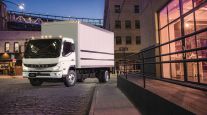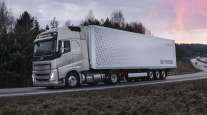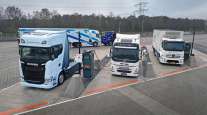Senior Reporter
Daimler Truck AG, Volvo Group Plan Joint Venture on Hydrogen Fuel Systems
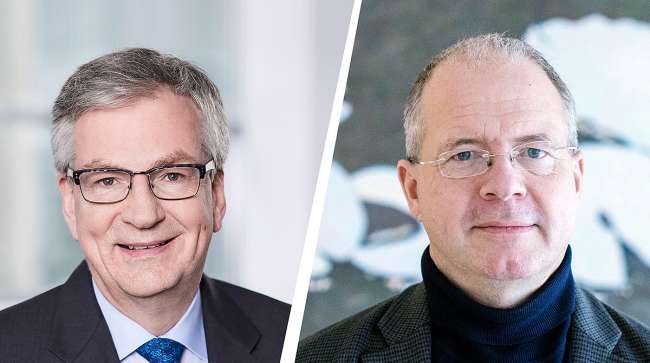
[Stay on top of transportation news: Get TTNews in your inbox.]
Global truck manufacturers Daimler Truck AG and Volvo Group have reached a preliminary agreement on a joint venture to develop, produce and commercialize fuel cell systems in heavy-duty vehicles by the second half of the decade.
The joint venture will operate as an independent and autonomous entity, with Daimler and Volvo continuing to be competitors in all other areas of business. Daimler will consolidate all of its current fuel cell activities in the joint venture, and Volvo Group will acquire 50% in the joint venture for $650 million.
The two have signed a preliminary nonbinding agreement, but a final agreement is expected by the third quarter of this year. The agreement is set to close before the end of this year.
The goal is for both companies to offer heavy-duty vehicles with fuel cells for demanding longhaul applications in series production in the second half of the decade, according to a statement from the companies. In addition, other automotive and nonautomotive use cases are part of the new joint effort’s scope.
.@VolvoGroup and @DaimlerTruckBus have signed a preliminary non-binding agreement to establish a new joint venture. The intention is to develop, produce and commercialize #FuelCell systems for heavy-duty vehicle applications and other use cases.
— Daimler AG (@Daimler) April 21, 2020
“This joint initiative with the Volvo Group is a milestone in bringing fuel cell-powered trucks and buses onto our roads,” Daimler Truck Chairman Martin Daum said in a news release.
“By forming this joint venture, we are clearly showing that we believe in hydrogen fuel cells for commercial vehicles. But for this vision to become reality, other companies and institutions also need to support and contribute to this development, not least in order to establish the fuel infrastructure needed,” Volvo Group CEO Martin Lundstedt said.
Joining forces will decrease development costs for both companies and accelerate the market introduction of fuel cell systems in products used for heavy-duty transport and demanding longhaul applications, the companies said. In the context of the current economic downturn, cooperation has become even more necessary to meet the Green Deal objectives in Europe within a feasible time frame.
The joint venture will include operations in Germany with production facilities in Germany and Canada.
The announcement was in line with what the North American Council for Freight Efficiency sees occurring with alternative fuels and technology bridges moving into the next decade, NACFE Executive Director Mike Roeth said.
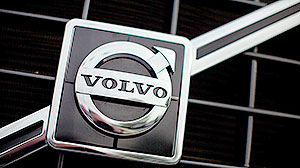
Volvo logo on a truck grille. (Justin Ide/Bloomberg News)
“Hydrogen does take a commitment from many parties to be successful. Even truck buyers to commit to scale in certain freight corridors and for the infrastructure to fuel the vehicles,” Roeth told Transport Topics. “Partnerships like this will bring together expertise that should bring hydrogen-electric trucks to the market faster and have fueling to maximize their operations.”
The leveraging of assets, as the plan proposes, “to advance technological innovation in an efficient and cost-effective manner is a prudent move that will reap rewards for both of these iconic companies,” said Glen Kedzie, American Trucking Associations’ energy and environmental affairs counsel.
“Given Europe’s far more progressive pathway in addressing climate change, truck manufacturers in the European Union are standing tall to meet the challenges of tomorrow by making considerable investments today,” Kedzie said.

Kedzie
In a March op-ed, European Commission President Ursula von der Leyen wrote, “When it comes to the future of our planet, the policy of being too cautious is riskiest of all. This is why one of our first actions was to launch the European Green Deal. At the heart of it is the goal to make Europe the first climate-neutral continent by 2050.”
The companies explained a hydrogen fuel cell converts the chemical energy of the fuel, in this case hydrogen, and oxygen in the air into electricity. The electricity powers the electrical motors that propel an electrical vehicle.
There are two main ways to produce the hydrogen needed. So-called green hydrogen can be produced locally at the gas station, using electricity to convert water into hydrogen. Blue hydrogen is expected to be produced from natural gas, utilizing carbon capture technology to create a carbon-neutral fuel.
The companies made the announcement April 21, one day before Earth Day 2020, the event’s 50th anniversary. Its theme this year is climate action.
Want more news? Listen to today's daily briefing:


